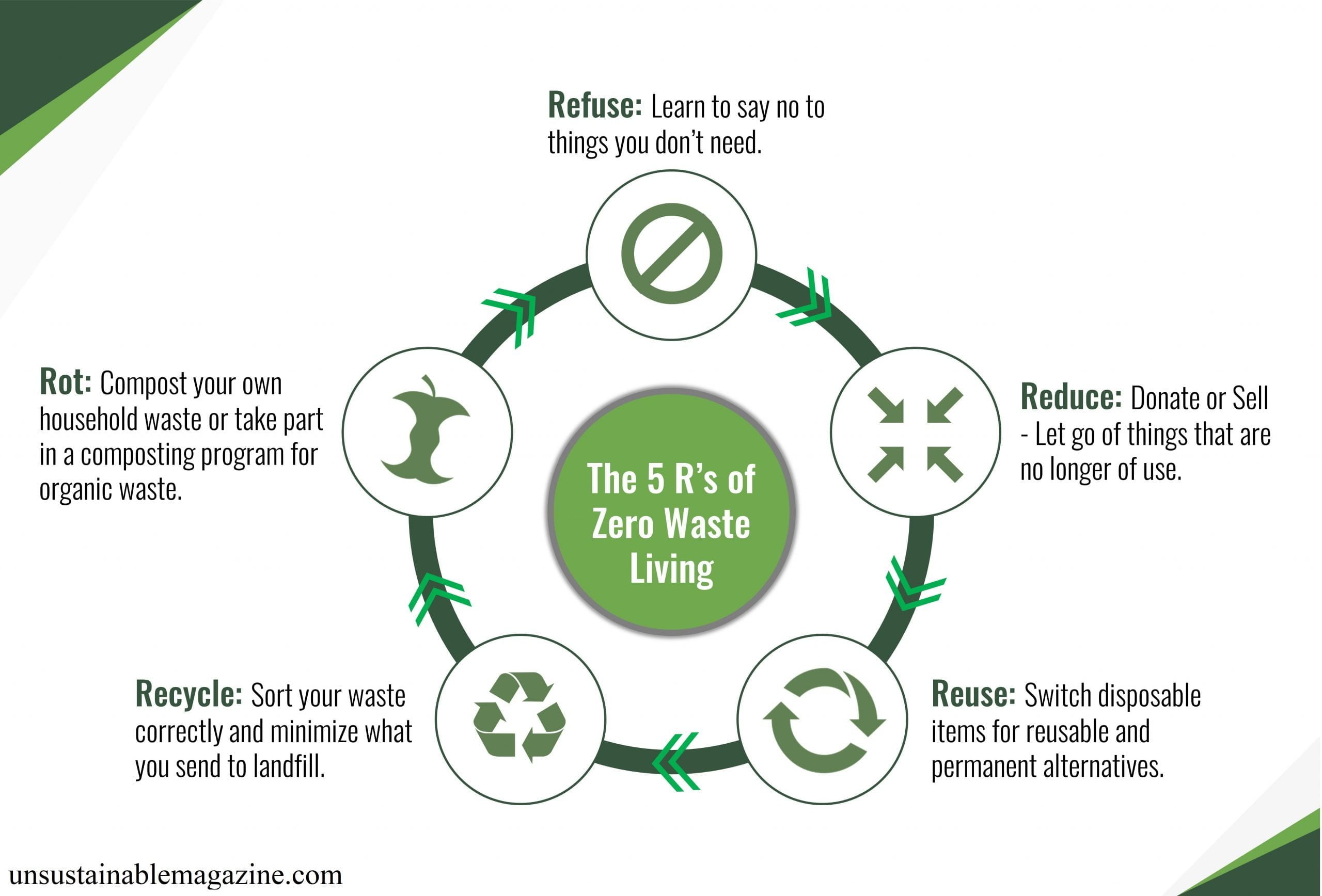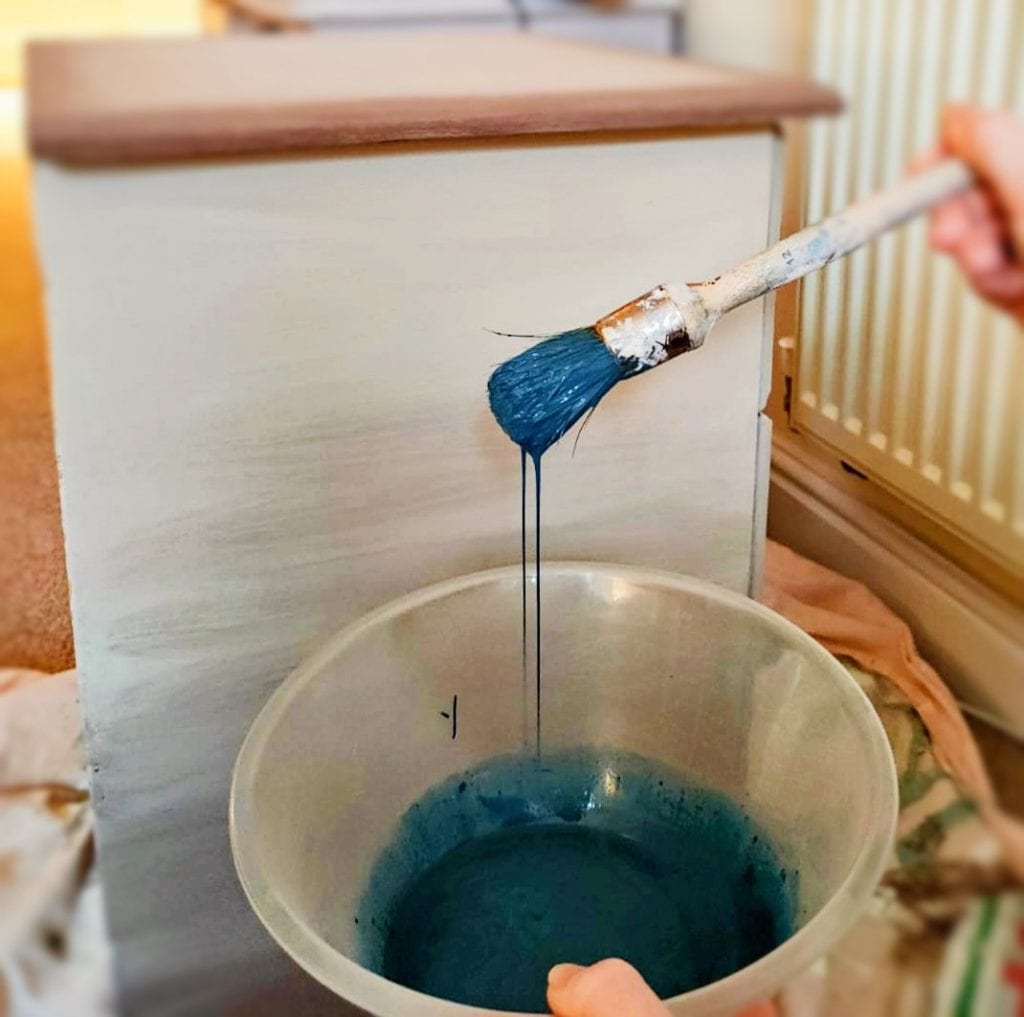A Guide to the 5 R’s of Waste Management and Zero Waste Living and the 5 R’s: Refuse and Reduce to bring less in; Reuse to maintain balance; Recycle when you can; Rot your kitchen scraps into compost.
By Dawn Cowles
When I was growing up there were only 3 R’s when it came to dealing with the global waste crisis. Reduce, reuse, and recycle were the words on everyone’s lips, from NGOs, government agencies, and waste management facilities, through to schools. The 3 R’s were used to educate the public, and they did a marvellous job. However, there are plenty more R’s out there if you want to live a more sustainable life, but for the purposes of zero waste living, 5 R’s more than serve the purpose.
What Are The 5 R’s of Waste Management?
In 2013, Bea Johnson launched a book that was to become the bible for zero-waste livers. The title was Zero Waste Home.
It’s a part inspirational story that tells how Bea transformed the life of herself and her family for the better by reducing their waste to an astounding one litre a year (one single mason jar).
All aspects of life are covered, from food and recipes to gift giving, holidays, maintenance, housing, travelling, outings, and much. It also introduces the 5 R’s of living zero waste.
They are:
- Refuse: Say no to what you don’t need.
- Reduce: Letting go of things that are no longer of use and donating or selling. It also means only focusing on necessary purchases.
- Reuse: Switching disposable items for reusable and permanent alternatives.
- Recycle: We’ve been made to believe that recycling is the go-to solution for waste reduction. In fact, it’s number four in the list behind refuse, reduce, and reuse.
- Rot: Compost your own household waste or take part in a composting program for organic waste.

While you might be a world away from squeezing all your waste into one single mason jar, you can still have the goal of leading as sustainable a life as is possible for you by adopting the 5 R’s of zero waste living. Here’s how you can do it.
The 5 R’s of Zero Waste Living

Refuse – Learn How to Say No and Mean It
This is my favourite R in the list because it means I have to think about everything I do and the environmental impact of my actions. It’s also the most important step to take if you want to prevent waste from entering your home in the first place. We’re given many things in our daily life which we don’t need.
Supermarket carrier bags are the most obvious culprit, but fortunately this is one problem that truly getting the attention it deserves, with many countries banning single use plastics.
There is still a long way to go, however. Despite them being banned in 32 countries, shoppers use 500 billion single-use plastic bags every year.
If carrier bags are not yet banned where you live, you can say NO! It’s not just carrier bags you can refuse either. Next time you go to the cinema or order a drive thru takeaway, say no to the plastic straw in your drink.
There are lots of other ways you can refuse by saying no:
- Flyers and business cards: If you’re offered one, take a picture of it using your phone, thereby negating the need for the physical item.
- Marketing freebies: We all like to receive things for free, but learn to say no if you don’t need them. Just because it’s free, don’t take that as a reason to accept it. Marketing freebies, such as pens and USB drives, are brilliant examples. If you know you won’t use them, leave them for someone who will.
- Chemical cleaners and air fresheners: These might seem like essential items, but you can make them at home with things you’ve already got in your cupboard.
- Single-use plastics and disposables: Included in this section are straws, cutlery, and plastic bags.
- Produce wrapped in plastic: Send a message to the supermarkets and only choose products that aren’t wrapped in plastic or netting. Shop for produce at your local farmer’s market, greengrocers, local food co-op, or direct from the farm.
- Free bottles of water: When you attend a conference or are flying, say no to the free bottle of water and take your own reusable water bottle instead.
- Junk mail: Stick a ‘no junk mail’ notice on your letter box to stop paper deliveries.
- Travel: Instead of your next carbon-heavy holiday, consider a much more environmentally friendly binge on travel TV shows.
- Art: Instead of buying physical pieces that take up space and resources, consider supporting digital graphic designers and online artists.

Reduce – Learn to Let Go
Reduce is about having a good clear out. All those items you’ve got lurking at the back of your cupboards that never seem to see the light of day, it’s time to give them to someone who can put them to better use.
You know the things I’m referring to:
- That enormous pile of jumpers you never get to wear.
- That thick wad of business cards you insist on carrying around in your wallet.
- A drawer full of pens that’ll last several decades.
- Bottles of body wash and shampoo that are so tiny you could put them in a doll’s house and they wouldn’t look out of place.
All these items have been manufactured, packaged, and transported at one point, and they ate up precious resources. Rather than hoarding unused and redundant items, redistribute them and help save our scarce resources.
There are many things you can do with these unwanted items.
Donate or sell them, for example.
In the US, a company called GoodWill accepts donations of new and gently used items. They sell items in their stores and the revenue is used to provide valuable employment training and job placement services for people in the community. Wherever you live in the world, there will be charitable organisations willing to take things you no longer need or want.
If you’d prefer to get some money back for the items, there are just as many online websites where you can sell your used items. eBay is the most well known, but there are a wealth of others.
There’s another angle to reducing.
It means shopping with a purpose and only buying what you need rather than giving in to random splurges. All too often, those random purchases end up stuck at the back of a cupboard or headed for the waste bin.
When you head to the store, think about whether the items you’re buying serve your best interests. Don’t allow yourself to get sucked in to the trap of hyper-consumerism.

Reuse – Make Sure Things Last as Long as They Can
We’ve become a bit of a throw away society.
As soon as something new comes along, we’re only too willing to trade our old models in for new ones. It’s called planned obsolescence. Many things are now designed to be short-lived and we’re forced to replace them faster.
It doesn’t, however, have to be that way. Items can be repaired, mended, or patched up and a little more life squeezed out of them. We can also reduce the chances of it breaking in the first place by doing your homework and opting for quality and repairability.
Reusing also refers to using reusable items rather than disposables. Consumables such as paper towels, wipes, and cotton balls are very convenient, but you use them once and then throw them in the bin.
You’re forced to replace them time and time again, spending money you could use for other things and wasting valuable resources.
For almost every single-use item there is a reusable alternative.
Let’s give you a few examples:
- Paper tissues – washable handkerchiefs
- Disposable razors – electric shaver or a straight-edge razor
- Paper towels – cotton cloths or microfibre
- Dish sponge – cotton cloth
- Tea bags – loose tea and a tea strainer
- Coffee pods – French press
- Baking parchment – grease or oil the pan or use a silicon mat
- Tin foil/cling film – use a food container or jar with a lid
- Paper bags/ plastic bags – bring your own cloth bag
- Bottled water – a glass or stainless steel water bottle and tap water
And the list goes on.

Recycle – For Those Things You Can’t Refuse, Reduce, or Reuse
This used to be number three in the waste management hierarchy, but it’s been relegated to number four. They have programmed us to believe that recycling is the answer to our global waste problem and the only way for it to be reduced. Recycling, however, is not the answer, particularly with plastic waste.
The value of recycling is severely limited. The recycling infrastructure is struggling to keep pace and recyclable materials are not successfully being recycled into new products.
When they are recycled, they tend to end up being downcycled into low-quality, disposable goods that eventually end up in the waste stream anyway. The recycling process is also highly energy intensive.
You should only consider recycling as a last resort. One that you only do after steps 1,2, and 3 have been exhausted.
And if you’ve done your best with the three previous steps you’ll have a lot less waste already.

Rot What’s Left
The ultimate step in the 5 R’s of zero waste living is to rot, in other words compost. You can do a lot with your food scraps rather than throw them in the waste bin. Compost them and you’ll be creating a nutrient rich fertiliser you can use in your garden. If you’re living in a one bedroom studio flat, you might think it’s impossible. It won’t be easy, but it is possible.
It’s estimated that 60% of landfills in the US are full of organic matter. Unfortunately, it doesn’t have time to break down because landfills aren’t aerated. Instead, the organic matter releases methane into the atmosphere, thereby hastening climate related issues. Because the organic materials are mixed together with inorganic materials, a perfect preserved atmosphere is created.
Indoor composting is what you need to be doing if you don’t have an outside space. Worm bins are the most common way to compost indoors. Make sure you keep a good mix of carbon (paper, cardboard, newspaper, dry leaves) and nitrogen (food scraps). Around 50/50 is best. Add to your compost bin some composting worms and you’re good to go.
Another option is a Bokashi Bin. It’s a big bucket into which you put all your composting material. You mash it down and then add an activator mix full of microbes that speeds up the decomposition process. Compost can be created in as little as 4 weeks.
Now you know what the 5 R’s are, you can make better choices. Remember that they go in order. Refusing and reducing means you’re bringing less into your home. Reusing means you’re keeping new things from being made and old things from being wasted. Practice the first three R’s and you’ll automatically have less stuff to recycle and rot.